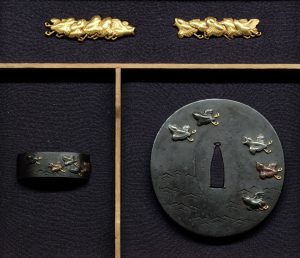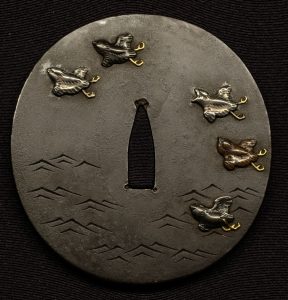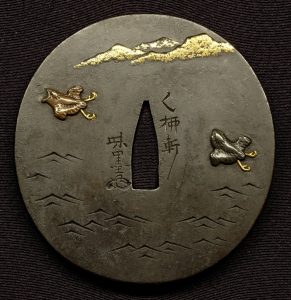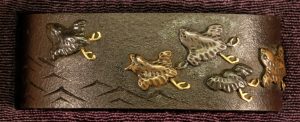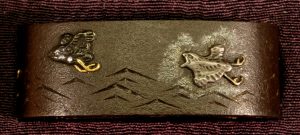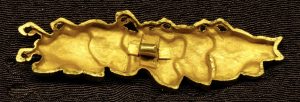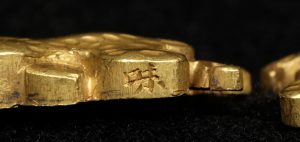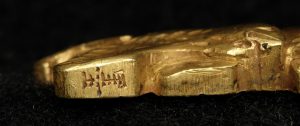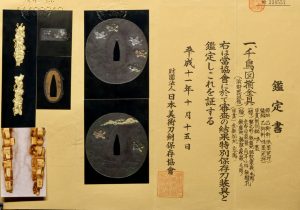Hamano Shozui / NBTHK Tokubetsu Hozon
MITOKORIMONO
HAMANO SHOZUI (SHODAI)
NBTHK TOKUBETSU HOZON
DATE: NONE
TSUBA MEI: OTSURYUKEN · MIBOKU (KAO)
TSUBA DIMENSIONS: 3” X 2.875” X 0.156”
NAKAGO ANA: 1” X 0.25”
FUCHI: 2” X 0.875”
ANA: 1” X 0.25”
MENUKI (SOLID GOLD): Signed Miboku
2” X 0.5” (weight 18gms)
PAPERS: NBTHK TOKUBETSU HOZON
FROM SESKO’S, TOSO KINKO SCHOOLS: The founder of the Hamano school was Shōzui, who was a student of Nara Toshinaga (利寿) mentioned in the genealogy on the previous page. His first name was „Tarōbei“ (太郎兵衛) and he was born in the ninth year of Genroku (1696). After finishing his apprenticeship with Toshinaga he parted with the Nara school and pursued very successful his own career. His school was very capable of keeping up with the Yokoya school in terms of number of students and influence on the machibori movement. Simply spoken, he combined the styles of the Yokoya and the Nara school with the interpretations of Sugiura Jōi, that means he worked in takabori-iroe and in zōgan but with larger-sized motifs than those use by the Nara school, enriched with usunikubori and shishiaibori. And regarding his selection of motifs, he chose various historical, epic, worldly and figurative subjects, as well as a broad variety of plants and animals.
Besides the Nara-sansaku (Nara Toshinaga, Sugiura Jōi and Tsuchiya Yasuchika), Shōzui is counted as the fourth great master that the Nara school has brought forth, i.e. the so-called „Nara Shitennō“ (奈良四天王). But it has to be mentioned that Shōzui and Jōi formed a rather somewhat separated pair in this group because there were about thirty years between them and the contemporaries Toshinaga and Yasuchika.
Regarding his signatures, he always used the old version (濱) for „Hama“ (浜) and zui“ (随) is also signed with the non-simplified style (隨). The „Tōsō-kodōgu-kōza“ assumes that the characters for „Shōzui“ were back then probably read by their Japanese reading „Masayuki“ and that the Sino-Japanese reading had became widely used only in recent times. By the way, the „Tōsō-kodōgu-kōza“ was published in 1972. However, the names of all subsequent generations are usually quoted in the Japanese reading.
Shōzui used more than a dozen pseudonyms, for example „Otsuryūken“ (乙柳軒),*49 „Miboku“ (味墨), “Shūhōsai“ (龝峰斎), „Yūkotei“ (遊壷亭), „Keitō“ (圭竇) and „Keitōrin“ (圭竇林). The gō „Otsuryūken“ and „Miboku“ in turn were also used by later Hamano mainline artists and it is said that students were not allowed to sign with these pseudonyms. Hamano Shōzui died on the 26th day of the tenth month of Meiwa six (1769) at the age of 74.
___________________
This exquisite mitokorimono depicts a motif of Chidori (plovers) in flight over waves by a famous and desirable maker, who also hails as the founder of the Hamano school, Shozui.
Both the tsuba and fuchi / kashira are an iron base with the adornments of Chidori crafted from shakudo, shibuichi and copper with gold highlights.
The menuki feature two groupings of Chidori fashioned from solid gold and are individually signed leaving no doubt they were made as a pair.
This set comes in a custom box which is housed inside an outer custom box (see photos).
This mitokorimono comes with Tokubetsu Hozon Kanteisho by the NBTHK.

